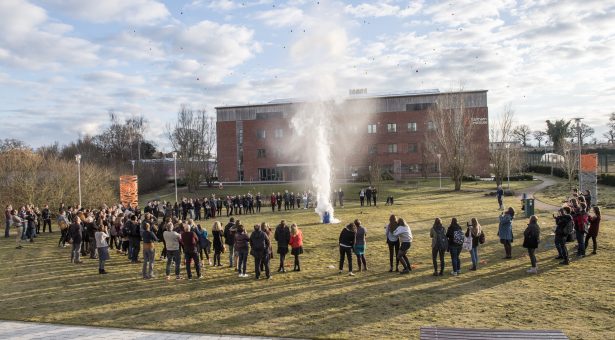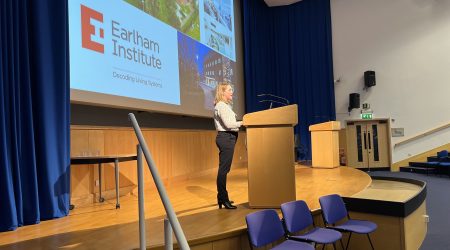Youth STEMM Award mid-term conference

Last week we hosted a Science Showcase to bring together many of the enthusiastic young people who are currently working towards a Youth STEMM Award, ranging from 13 to 18 years old and coming from schools across Norfolk and Suffolk.
Held in the John Innes Conference Centre, the showcase saw PhD students and researchers from the John Innes Centre, The Sainsbury Laboratory, the University of East Anglia and the Quadram Institute, come together to highlight the variety of science taking place and share first-hand experiences of their careers in STEMM (Science, Technology, Engineering, Maths and Medicine).
Samantha Fox, Director of the Youth STEMM Award and a researcher in the Enrico Coen lab at the John Innes Centre said; “The point of doing this event is to bring together many of the students taking part in the Award, giving them the opportunity to engage directly with scientists and be excited by the cutting edge research taking place right here in Norfolk.”
“By getting the students to talk to scientists about their own careers, we can broaden horizons by showing that there are lots of options out there and hopefully inspire the next generation of STEMM professionals.”
“During the event there were some fantastic exhibits for the students to get hands-on with, including infiltrating plant leaves – a technique we use in the lab. Microscopes allowed the students to delve into carnivorous badderwort traps and find out how plants make their amazing shapes. There was also a ‘Guess the image’ game with some fantastic high magnification photographs of everyday objects taken by our bioimaging team.”
The most dramatic moment of the event was delivered by the extraordinary volcano demonstration from the UEA’s volcanologist Professor Jenni Barclay, who went on to give a hugely entertaining keynote talk about her work and career.
“The volcano experiment was really cool” enthused Beth Scarlett, who attends Bungay High School and is considering a career in science; “At school I do Maths, Chemistry and Biology, plus an extended project on a topic of your choice, mine is on the genetics of breast cancer. I like that the Youth STEMM awards allow me to learn new things”.
Fellow student Caitlin Fox from Taverham High School was equally captivated by the variety of options open to her; “I am interested in a STEMM career. I don’t know exactly what I want to do yet but events like this give me an idea of the different options that are out there.”
The broadening of the student’s horizons to the possibilities that exist in STEMM was a thought echoed by Vicky Barron, Head of Biology at Bungay High School, who explained;
“I think Youth STEMM and events like this, really open the children’s eyes to places like the John Innes Centre. Being from a small market town, major research institutes aren’t places the children would normally get to visit. This gives them that chance and shows them there are lots of options for STEMM related careers.”
Offering students, a broad range of options is vital to allowing them to find what it is they enjoy and discover what they are passionate about.
Emma Holden, a PhD student at the Quadram Institute told the story of how she always knew she wanted to work within science, but it took getting involved to discover the field she wanted to focus on.
“I started doing a degree in zoology but realised that wasn’t for me, so I moved into evolutionary biology looking at the co-evolution of bacteria and viruses and their interaction with the environment. That took me into antimicrobial resistance and then on to medical applications. You could say my career evolved to meet my passion for evolutionary biology.”
“Currently, I am looking at antimicrobial resistance in gram-negative pathogens, working on efflux pumps and biofilm formation. Basically, these are two ways in which human pathogens like E. coli and Salmonella form resistance to antibiotics, and they are linked in a way we don’t fully understand. Antibiotic resistance is a major problem for medical reasons, but also in terms of food hygiene, water treatment and domestic cleaning products, so it’s vitally important that we understand what causes it and how we can stop it.”
“I really love science and I love the work that I’m doing here”.
Get involved
The Youth STEMM Award has three different levels: Bronze, Silver and Gold.
If you’re currently in Years 9 to 13 you can get involved straight away, by registering your interest here.
You can also find out more by following the Youth STEMM Award on Twitter – @YouthSTEMM.

